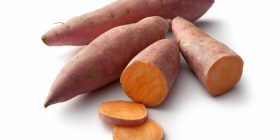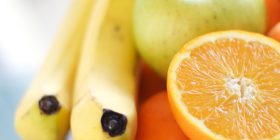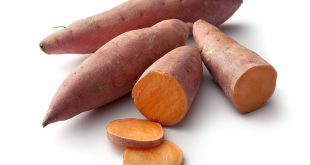The Glycemic Index
Reaching and maintaining target blood glucose levels is a key part of diabetes management. Glucose is created when carbohydrates (carbs) are digested, but different types of carbs can impact blood glucose differently. The Glycemic Index (GI) assigns a carb food a number on a scale from 0 to 100 according to how much it raises blood glucose following the ingestion of a serving size that contains 50g of carbohydrate.
Carbohydrate foods can be classified as being low GI, medium GI, or high GI. You can think of this as meaning slow-acting, in-between, or fast-acting effects on blood glucose levels. People with diabetes should choose mostly low GI foods. Eating a low GI food will not raise the blood sugar as high, 2 hours after eating it, as a high GI food would.
Low GI foods have a GI below 55; medium GI foods have a GI between 55 and 70; high GI foods have a GI over 70. For examples of low, medium and high GI foods, click here.
A dietitian will help you plan meals with a focus on low GI and medium GI foods like non-starchy vegetables, whole grain breads and cereals, and whole grain snacks.
The Glycemic Load
The Glycemic Index is based on serving sizes of food that contain 50 grams of carbs – a portion that is not always realistic for a given food. For example, watermelon is considered to be a high GI food, but one slice contains only 6 grams of carbohydrates. The GI reflects the impact on blood sugar after eating more than 8 slices! In order to account for appropriate serving sizes, the Glycemic Load (GL) was created as a more accurate meal-planning tool.
The Glycemic Load multiplies the amount of carbs in a realistic portion of a given food by its GI. For example, to calculate the GL of one watermelon slice, you multiply its GI (72) by its carb content (6 grams per serving) and divide by 100. This gives one slice of watermelon a low GL of 4.3.
Low GL foods have a GL below 10; medium GL foods have a GL between 11 and 19; high GL foods have a GL over 20. People with diabetes should choose mostly low GL foods. See the chart below to learn which foods have a low GL.
| FOOD AND SERVING SIZE | GL | GI |
| LOW GL: | ||
| Hummus (chickpea dip) (30g) | 0 | 6 |
| Milk, skim (250mL) | 4 | 32 |
| Grapefruit (120g) | 3 | 25 |
| Cashews, salted (50g) | 3 | 27 |
| Green peas, average (50g) | 4 | 51 |
| Orange, average (120g) | 4 | 40 |
| Lentils (150g) | 5 | 29 |
| Pumpernickel bread (30g) | 7 | 56 |
| Apple, average (120g) | 6 | 39 |
| Black beans (150g) | 7 | 30 |
| Wheat tortilla (50g) | 8 | 30 |
| MODERATE GL: | ||
| Corn tortilla (50g) | 12 | 52 |
| Soda crackers (25g) | 12 | 74 |
| Navy beans (150g) | 9 | 31 |
| Oatmeal (250g) | 13 | 55 |
| Banana (120g) | 16 | 62 |
| Graham crackers (25g) | 14 | 74 |
| Rice cakes (25g) | 17 | 82 |
| Sweet potato, peeled, cubed, boiled in salted water, 15 min (150g) | 18 | 59 |
| Brown rice (150g) | 16 | 50 |
| HIGH GL: | ||
| Cornflakes (30g) | 23 | 93 |
| Pizza, plain with tomato sauce and parmesan cheese (100g) | 22 | 80 |
| White rice (150g) | 43 | 89 |
| Macaroni (180g) | 23 | 47 |
| Cranberry juice (250mL) | 24 | 68 |
| Bagel, white, frozen (70g) | 25 | 72 |
| Spaghetti, white, boiled (180g) | 22 | 46 |
| Raisins (60g) | 28 | 64 |
| Macaroni and Cheese (Kraft) (180g) | 32 | 64 |
Adapted from: http://bit.ly/19fUWtk
It is important to remember that there is no concrete evidence that low GI/GL diets reduce weight or provide other healthy long-term outcomes. From a practical point of view, most people eat a variety of foods and not single foods at one time. While a single food may have a low or high glycemic index, a meal may combine foods of a variety of types, which limits the applicability of the glycemic index to the way most people eat.
Try not to be confused by GI and GL. They simply provide an explanation for the effect of different types of carbs on blood sugar levels and can be used alongside other healthy eating tools, such as carb counting. Always get the advice from a registered dietitian on how to incorporate GI and GL into your daily food choices.
 Diabetes Care Community Learn, connect and care
Diabetes Care Community Learn, connect and care






